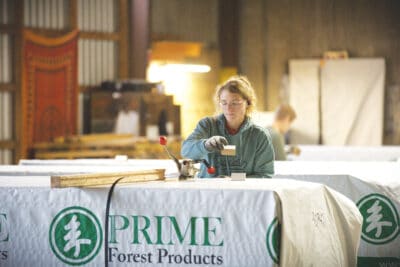
With the building season moving into full swing, demand for preserved wood to build outdoor projects will pick up significantly. Ensure your customers will build long-lasting structures by providing them with two key components to go with the wood: the proper fasteners and field treatments.
Today’s wood preservatives contain more copper than treatments used in the past. This increases the potential for corrosion of the steel in fasteners like nails or screws. However, using the proper fastener can minimize this potential corrosion.
Fastener corrosion can happen as the ions in the copper carried in a preservative can create a chemical reaction with the steel in a nail, screw, bolt or other hardware. Since preserved wood is typically used where there is regular exposure to moisture, water may add to the chemical reaction between the two metals and cause corrosion and staining.
Because of this, treaters and preservative manufacturers recommend that fasteners and hardware be hot-dipped galvanized steel, stainless steel, silicon bronze or copper. Building codes list the same requirements, with an exception for borate-treated wood such as sill plates.
The most commonly used fasteners for preserved wood are hot-dipped galvanized steel, which are typically dull gray in appearance. These are made by dipping the fasteners under high temperatures to bond a protective coating of zinc to the steel.
Hot-dipped galvanized fasteners are recommended for use with all preservatives. The International Building Code requires fasteners used with preserved wood meet “a minimum of ASTM A 653, type G185 zinc-coated galvanized steel, or equivalent.”
Stainless steel is a popular corrosion resistant material used for fasteners. Considered the highest quality, stainless steel is more expensive than comparable hot-dipped galvanized products. However, more cost-effective stainless steel products have come on the market in recent years. In areas where there is extensive exposure to moisture or salt water, stainless steel is the preferred choice.
In addition to using the proper fastener, field treating cuts and holes made in preserved wood during construction is critical to maintaining the durability of the wood.
Pressure treating forces preservatives into the surface of the wood, creating a protective shell that keeps decay fungi, termites and other insects at bay. However, that protection does not go all the way through the wood and is only on the outside surface.
Cutting and drilling holes can expose wood that did not receive treatment. Applying field treating during construction keeps the protective layer intact and extends the longevity of wood in service.
The most commonly available preservative for field treating wood is copper naphthenate, or CuN. There are a variety of copper naphthenate-based preservatives available that contain the minimum 2% copper as recommended by industry standards. Formulations using copper naphthenate with 1% copper also may be used where the higher copper content field treatments are not readily available.
Preservatives with oxine copper also can be used for field treating. Oxine copper is typically used for treating larger wood products such as log homes, utility poles and guardrail posts, but is also suitable for decks. Oxine copper preservatives, containing the recommended minimum 0.12% copper metal, are available colorless or in various colors and have little odor.
The newest preservative approved for field treating is Micronized Copper Quaternary, or MCQ. The American Wood Protection Assn. approved the use of MCQ for field treating this year.
Field treating is done using a brush to apply the preservative to the cut area or hole. Follow the preservative’s label for application instructions. When field treating wood placed over water, care should be taken to avoid dripping the preservative into the water.
The surface of the area treated should be cleaned before application, then coated liberally so the treatment can penetrate into the fiber. A standard paint brush can be used for most field treating. Be sure to coat all cuts, including the ends, and apply the preservative deep into the holes.
Stocking the proper fasteners and field treatment preservatives can go a long way in helping customers build decks and other outdoor structures that last.
For more information on fasteners and field treatments for preserved wood, go to the online technical library at PreservedWood.org.









